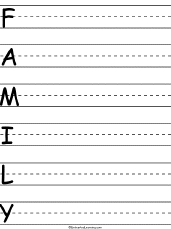What is an acrostic poem?
An acrostic poem, sometimes called a name poem, uses a word for its subject. Then each line of the poem begins with a letter from the subject word. This type of poetry doesn't have to rhyme.
Here's an example using the word school:
School is where I go
Computers, spirals, books, and more
Homework every day
On math, science, reading, and social studies
Our class does lots of fun projects
Learning never stops
How do I write an acrostic poem?
For your first try, you might want to use your first name as your subject word.
1.Write the subject of your poem vertically (up and down)on a piece of paper.
2. Brainstorm a list of words/ideas to include in the poem. Think of any words that might go with your subject word. Don't try to only think of words that begin with the letters in your subject word, list anything you think of. You can make the words/ideas fit later.
3. Look through the list of words/ideas. Begin to decide how they might fit into the poem. **Often a word you want to put into the poem doesn't begin with the letters found in the subject word. Think how that word could be put into a sentence that begins with a letter from the subject word. Here's an example from the school poem:
4. Work through all the letters of your subject word until you have created a line for each letter. Sometimes this can be tough. The first idea isn't always the best. You may need to think of some new words that describe your subject word to complete your poem.
Fonte: http://www.teachnet-lab.org/miami/2003/sampedro/what_is_an_acrostic_poem.htm
Family
a. Definition
"The term" family "is derived from the Latin" famulus "which means" household slave ". This term was coined in ancient Rome to appoint a new social group that emerged among the Latin tribes, to be made to agriculture and also legalized slavery.
IBGE for the definition of family is:
"A group of people bound by ties of kinship, dependency or domestic standards of living, all residents in the same house."
The Statute of the Child and Adolescent ACE (Act 9069 of 1990), in its Article 4, in the preliminary provisions, lists the family as the first pillars of social responsibility and duties to be with child and adolescent.
b. Family structures
Reflecting the cultural and social transformations, today, the family presents itself heterogeneous and changeable, assuming various forms of structuring. It is necessary to demystify the idealization of a given family structure as the "natural", opening the way for the recognition of the diversity of family organizations in the historical context, social and cultural.
According to Alberto Eiguer, French psychoanalyst, a family group may take the following structures:
the Conjugal Nuclear - consisting of a man, a woman and her children.
the Nuclear-Parent - parents only because of social phenomena like divorce, death, abandonment of home or even adoption of children by one person;
the extended family or kin - is the nuclear family more direct or collateral relatives.
The Family community alternatives - in which the role of parents is decentralized, and children become the responsibility of all adult members;
the alternative gay families - where there is a partnership between two persons of the same sex, which may include biological children or adopted children of one or both partners.


No comments:
Post a Comment